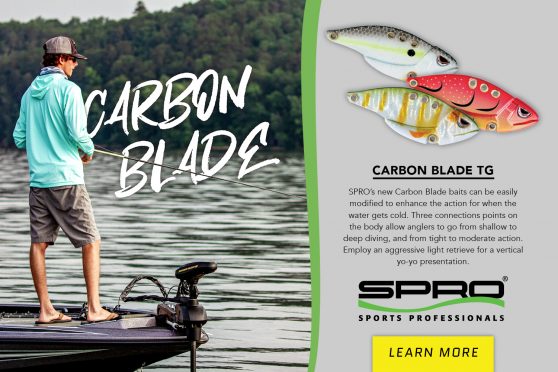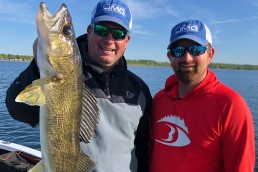Glide Baits for Fall Walleyes
SHARE THIS POST
 Jason Mitchell uses jigging minnows, also known as glide baits, for late-fall walleye success.
Jason Mitchell uses jigging minnows, also known as glide baits, for late-fall walleye success.
Glide baits or jigging minnows have become extremely popular with walleye anglers. While these heavy horizontal profile lures can be fished in shallow water, the weight of these lures gives them the added versatility of casting or jigging them over deep water. These lures can be fished with pinpoint precision over specific pieces of structure, like deep boulders and rock, or used to cast at specific fish if you are using electronics equipped with Active Target or Live Sight features.
To use these lures effectively, let’s highlight a few important aspects and explain some of the nuances to fishing these lures effectively.
While you can cast and cover plenty of water with these lures, this lure category shines whenever you are working in tight spaces. Say you have fish bunched up in a current spot between two islands in fall, or that the fish are piled onto a specific side of a deep point or using an isolated rock pile in the basin—all top fall locations. When fish are bunched up, you can often turn them on with glide baits, which just seem to trigger a reaction we seldom see with other presentations.
For water deeper than 20 feet, I am a big fan of using braided line like 8-pound Fireline. Some anglers prefer to use monofilament, which I like when I am pitching these lures in less than 10 feet of water. But in deeper water, I feel I get better hookups using braid. Below the braid, I use a small barrel swivel to combat line twist and prefer adding a heavier 10- to 14-pound fluorocarbon leader that is 2 to 3 feet long. The rod is important, too. I prefer a medium-fast action rod that allows me to really pop the lure when I snap the rod. The rod needs to be fast enough where it doesn’t load up when you snap the lure. As you snap the lure, each rod snap is basically a hookset, as many fish will hit between snaps and as they pin the bait to the bottom.
The productive cadence can vary somewhat from day to day, and each lure will seem to have a sweet spot as far as the stroke height and velocity of the snap. Many walleye anglers trying to learn this system don’t snap these lures hard enough to trigger the reaction bite. We are often snapping these baits hard enough where you can hear the rod snap forward. With many lures, we are snapping the baits a few feet or more.
Most of these lures seem to catch more fish if there is some slack line on the fall, so let the lure snap forward and fall on slack line. Often, we let them hit the bottom on slack line, and that’s when the fish hit, either hitting at the bottom of the glide on slack line or pinning the lure to the bottom. As you snap the rod forward, the fish are just on. That’s why the rod is so important. Each snap could be a hookset, so the snap forward must have enough power to set the hook.
When casting, it often seems to work better if you position the boat deep and cast shallower, working the lure from shallow to deep. Let the lure snap and glide down the structure whenever possible, as it seems like the lures snag up much less.
Are you enjoying this post?
You can be among the first to get the latest info on where to go, what to use and how to use it!
If you are fishing a hard bottom with rock and boulders, you can clip off the front hook that is on most glide baits. If you fish a lot of rock, you will love the solid Zink construction of the Tikka Mino, as there are no plastic fins to break on this lure. Some anglers also reinforce the plastic fins of their glide baits with super glue.
The other component that makes this presentation so effective is using your electronics to catch specific fish or at least make casts towards specific groups of fish. When using active sonar, it is amazing to see how far fish will follow a lure, and the distance some fish will travel to hit the lure. I have my Active Target transducer mounted to a Brew City mount so I can pan and look for fish. There are times when I can watch the glide bait come through the fish. Probably the only learning curve to using this technology is learning to cast beyond the fish so that the lure can work in front of the fish on a cast.
Another phenomenon that often happens when you spot lock over a location and cast around the boat is the number of fish that eventually accumulate below the boat. I find that I often catch fish right below the boat, and many fish will follow until the lure gets below the boat. So don’t be afraid to fish below the boat at the end of a cast.
When a fish eats a glide bait, there won’t be a doubt in your mind. This presentation resembles blade baits in that you will snag some fish or catch some fish outside the mouth, especially when the fish are pinning the lure to the bottom. Despite the wild snap up off the bottom and the erratic glide back down to the bottom, most fish will simply swallow the lure.
Fall walleyes often stack up on specific pieces of structure, and walleyes are notorious for using sharp-breaking structure in fall. Glide baits enable you to trigger fish while still positioning on spot-on-the-spot locations and to work up or down this structure with a presentation that brings out aggression. Build confidence with this presentation and you are going to put more fall walleye in the boat.
Have all this great information delivered to your front door or email! Subscribe to MidWest Outdoors on our website.
MWO
SHARE THIS POST
You may also like...
Nothing found.
Did you enjoy this post?
You can be among the first to get the latest info on where to go, what to use and how to use it!
Jason Mitchell
Jason Mitchell was a top walleye guide on Devils Lake, N.D. for nearly 20 years. Today, Mitchell produces the Jason Mitchell Outdoors TV program. Visit jasonmitchelloutdoors.com for more.
